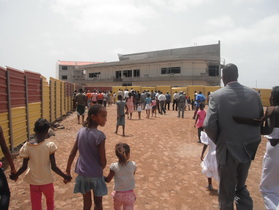 People start gathering around the cross to pray. On May 3rd, people in Maio celebrated their most important traditional event of the year: the Festa de Santa Cruz. It commemorates the end of slavery on the island - a very recent event. Slavery continued to take place unofficially well into the 20th century. My friend and colleague Eusa, who is my age, told me that her grandfather was a slave. People start collecting money and food for the Santa Cruz party more than a month in advance. Every night, they walk from house to house, dancing, singing and making music with instruments such as drums or búzio (a conch shell). This event is called tambour (from the French word for "drums"). When the revelers knock on your door, as long as you give something, no matter how little, your praises will be sung in the street. If you don't give anything, you will be loudly insulted for everyone to hear. And trust me, on a small island like Maio, it doesn't take long before everyone knows about your stinginess, and your reputation is ruined. Maybe I should use some of these fundraising techniques for my own organization, FMB? A week before the celebrations, people start putting out corn to dry on the main square, and then meet to grind it. This corn is then used in traditional dishes such as cachupa, xerém and cuscus (if you are curious about these dishes, click on the word "cachupa"!). On the day of Santa Cruz, the celebrations start with a procession, called tabanka. At midday, people wearing traditional black and white clothes gather in front of the house of the King of Santa Cruz, singing, dancing and playing drums. From there, the procession walks to the Queen's house to pick her up, before heading down to the beach where the cross (santissíma cruz) is located. People then gather around it to pray, and everyone takes turns to kiss it. Afterwards, the procession takes shape again and heads back to town for the party to begin. Food is cooked in open air on the main square, and people eat and dance all afternoon. So what does the Festa de Santa Cruz have to do with my work as a conservation scientist with FMB? Well, take a look at the picture of the place where the praying for Santa Cruz took place. Only a year ago, there would have been nothing in the background but the beaches and sea. Now, as you can see, this has been replaced by a construction site for a new hotel. This project not only had a devastating impact on Maio’s natural heritage (especially on nesting turtles and birds), but also on its cultural heritage. The people of Maio are terribly frustrated that one of Maio’s most important cultural sites was thus disfigured by the construction of this tourist resort. This is a very telling example of our philosophy at FMB: nature and culture often go hand in hand, and what is in the interest of the environment can also be in the interest of people. It does not always have to be the fight of Man against nature, or vice-versa. As the unique traditions of the Festa de Santa Cruz show, Maio is a place that has so much to offer. The island deserves better than tourists solely interested in swimming pools (why even bother going down to the beach?) and in getting sunburned. Tourism is both an economical reality and an economical necessity in Maio. However, there are alternatives to the mass tourism exemplified by the construction site of the picture: Maio should target visitors that are respectful of and interested in its nature, its culture and the lives of its people.
2 Comments
4/16/2012 What is "Maio"?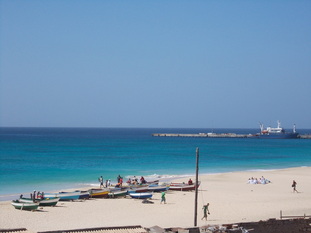 Beach of Vila do Maio, the main (and only) town in Maio Since September 2011 I have been working in Maio to set up a new NGO, "Fundação Maio Biodiversidade" (FMB for short). Our goal is to protect the unique fauna and flora of the island. Before I tell you about my work here with FMB, let me tell you a few things about Maio, so you can better picture where I live and work. Economy Maio is one of the ten islands of the Republic of Cape Verde, a country situated in the Atlantic Ocean, West of Senegal. While Maio is the island the closest to Santiago and the capital Praia, it is also the least developed and the least frequented by tourists: a 2010 census showed that it has only 6952 inhabitants. Their main sources of income are agriculture and fishing (on the picture you can see fishermen coming back with their boats on Bitche Rocha, the beach of Vila do Maio). People in Maio also heavily depend on money sent by the diaspora - family members who live abroad (mainly Rotterdam, Boston and Portugal). This diaspora is a key element of Cape Verdean life and culture. It is very common here to have parents, children and even a spouse all living in different countries - or at the very least in different islands of the archipelago. Music Missing your friends, family and country - or sodade in Creole, is expressed in morna, a genre of Cape Verdean music, sung by the famous Cesaria Evora. Music lies at the heart of the lives of Cape Verdeans: be it morna, zouk or funana, here in Maio you are constantly surrounded by people singing and dancing. While many of these genres are unique to Cape Verde, they share characteristics with music from Portugal (fado) and from former Portuguese colonies such as Angola (kizomba for example). Cultural and Natural Heritage Maio, a previously uninhabited island, was discovered in 1460 by the Portuguese, and was first populated 30 years later. The economy of the island stagnated until the end of the sixteenth century, when the English started to produce salt in the “salinas” of Maio and to export it to North America. The production eventually slowed down because of competition from other parts of the world, and today very little salt is still being produced. The Salina in Vila do Maio, as well as its surrounding sand dunes and semi-desert areas, are home to many birds including migratory shorebirds and wading birds. They provide nesting grounds for marine turtles (Caretta caretta), geckos and skins (Tarentola rudis, Mabuya spinalis), larks, an endemic subspecies of the cream-colored courser (Cursorius curser excul) and the largest breeding Kentish plover (Charadrius alexandrinus) population in the Atlantic Oceanic Islands. The waters around the island are rich in coral reefs and provide breeding grounds for species such as the humpback whale. There are many more things to say about Maio, but I hope that for now this short description will give you an idea of why I love this place and why FMB thinks it is crucial to protect it! |
Nature Conservation in Cape Verde: Whales, Turtles and Funana
Since September 2011, I've been setting up the NGO "Fundação Maio Biodiversidade" to protect the fauna and flora of Maio, an island in the Cape Verde archipelago. Look out for posts about the NGO's work and about life in Cape Verde in general! If you're interested in an internship with us, have a look at our website (www.maioconservation.org) and contact me here. About the Author:
My name is Elisa, I am French with Belgian parents, studied Organismic and Evolutionary Biology at Harvard ('11) for my bachelor's, and am now working with a nature conservancy NGO in Maio, Cape Verde. That's where I got to see this amazing loggerhead turtle!
Contact me here! ArchivesCategoriesAll About Maio Cape Verde Fishing Fmb Species Tourism Blog Homepage |
The Scientista Foundation, Inc. All Rights Reserved © 2011-2021 | Based in NY | [email protected]
The Network for Pre-Professional Women in Science and Engineering
The Scientista Foundation is a registered 501(c)(3) -- Donate!
The Network for Pre-Professional Women in Science and Engineering
The Scientista Foundation is a registered 501(c)(3) -- Donate!

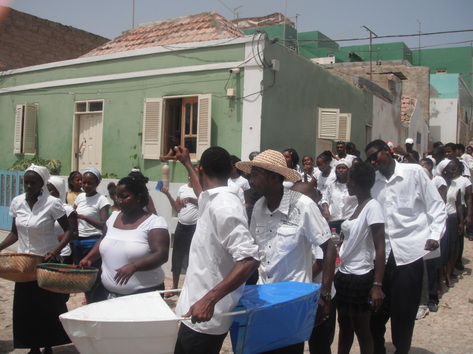
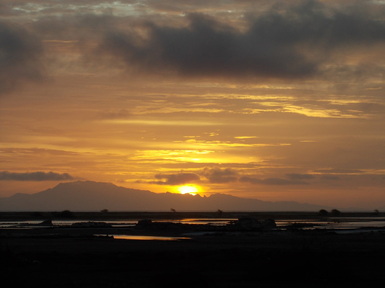
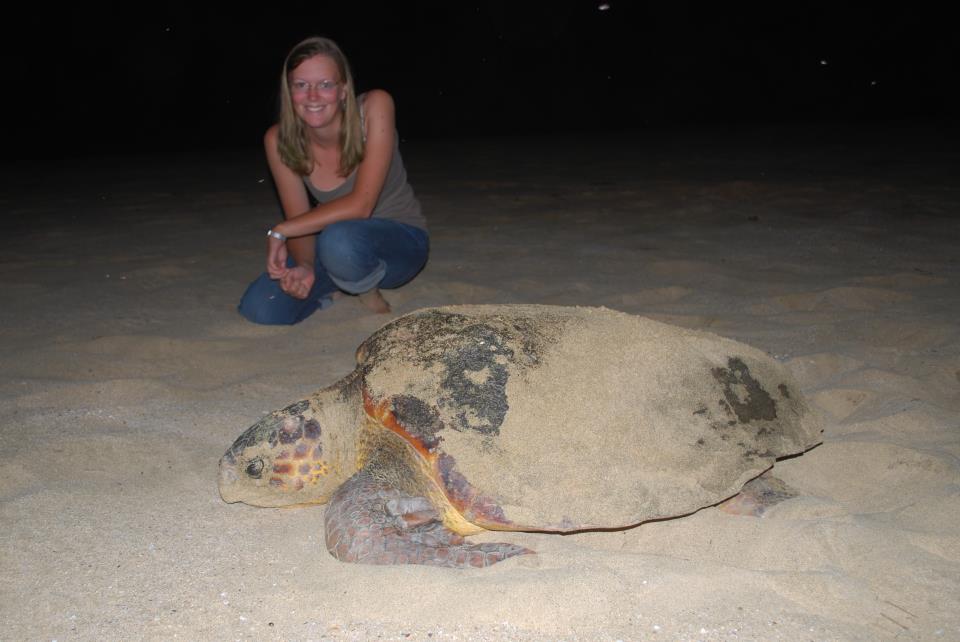
 RSS Feed
RSS Feed